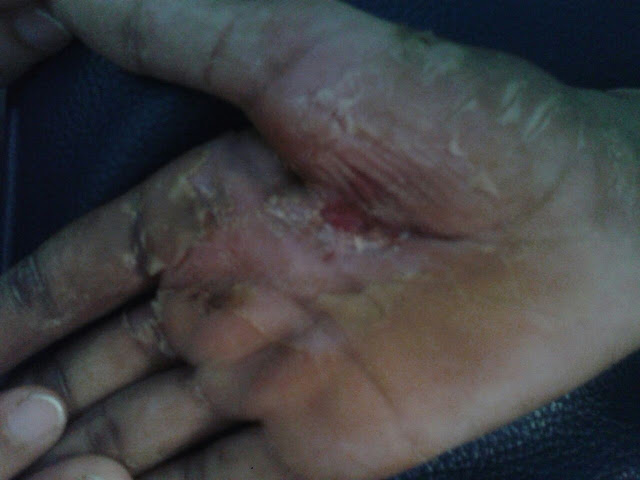Everyone of us aim to progress in life and dream to become a successful professional. We look high upon the professionals who have reached a certain height in their respective fields. But this doesnt come so easy. It is rightly said IF YOU DONT BUILD YOUR DREAMS, SOMEONE WILL HIRE YOU TO BUILD THEIRS. And to build our dreams apart from hard work we need a different thought process, innovations in the way we do our work and of course thorough knowledge of the subject with its application
A physiotherapist opening a new clinic will think of all equipments like electrotherapy equipments, exercise gadgets etc. But if said do buy one EMG NCV reply, he will give me this look
Somehow there is a phobia amongst physiotherapist regarding even looking at this equipment.
In our routine day to day clinical set up, we come across so many different varieties of patients ranging from DQ to radiculopathy and neuropathy. A physiotherapist specialized in Orthopedic Physiotherapy will have an orthopedic perspective in treating such patients. He will be restricted to muscles, joints, ligaments and manual therapy.The one specialized in Neurology will have his own perspective. He will restrict his thought process mainly to brain and spinal cord. And in this visualization, ultimately Peripheral Nervous System gets ignored and unexplored. That is the main reason why EMG NCV equipment and the concept itself has created a fear among physiotherapist. But let us see altogether different perspective to this which can create wonders to your patients
In our routine day to day clinical set up, we come across so many different varieties of patients ranging from DQ to radiculopathy and neuropathy. A physiotherapist specialized in Orthopedic Physiotherapy will have an orthopedic perspective in treating such patients. He will be restricted to muscles, joints, ligaments and manual therapy.The one specialized in Neurology will have his own perspective. He will restrict his thought process mainly to brain and spinal cord. And in this visualization, ultimately Peripheral Nervous System gets ignored and unexplored. That is the main reason why EMG NCV equipment and the concept itself has created a fear among physiotherapist. But let us see altogether different perspective to this which can create wonders to your patients
So many times we come across patients who inspite of being treated for days and months show little or no improvement. All our treatment modifications, techniques and advices prove worthless and we wonder now what.These are the times when EMG NCV equipment serves two purpose. One is it helps in further investigating the problem and secondly a therapist can charge more for performing a test. We may do mere NCV studies which does not require any certification. We may not give report as given in a electrophysiological studies. This can be mere one of our investigation just like Strength Duration Curve. But definitely helps.
Many neurologists adopt this. They screen the patient with NCV studies. Without releasing an official report but can come to a conclusion. We have seen so many Orthopedicians having X-ray machine in their clinic itself and so taking X-rays for the patient are just one step away. Why cant we have EMG NCV equipment?
Very few of us are aware about Pronator Teres syndrome, Ligament of Struther's syndrome which are entrapment of Median nerve at/around elbow which are often mistaken as Carpal tunnel Syndrome. Our neural tissue mobilization for such patients is focussed at wrist and hence inspite of putting all efforts, patient hardly improves. This is the time one may think of performing NCV study and reconfirm the diagnosis which can improve patient's outcome. Patients taking treatment for Tennis elbow or Lateral epicondylitis are one more example. All sort of electrotherapy, taping, manual therapy etc without much improvement leaves us in surprise and patient ultimately loses faith. Very few of us are aware of the fact that compression of Radial nerve between the heads of supinator traditionally called Supinator tunnel syndrome mimics Lateral epicondylitis. All symptoms usually are same as pain in wrist extension and weakness of wrist and finger extension which blindfold us to believe that this is due to pain which may not be the case. Simple NCV study can help detecting it and ultimately better patient outcome. Superficial Radial sensory nerve compression due to tight wrist bands can mimic radiculopathy. Patients take treatment of radiculopathy all in vain and ultimately they lose faith in us. Sensory Radial conduction abnormality can help detect this. Suprascapular nerve neuropathy patient mistaken for Rotator cuff injury patient which again changes the treatment protocol and hence the patient outcome. Tarsal tunnel syndrome, radiculopathy and neuropathy have nearly same kind of sensory symptoms. Treating such wrongly diagnosed patients can definitely affect the clinical practice and patient - doctor trust and relationship. Simple NCV studies can help over come this serious problem. Such unknown entrapments are many. The list is beyond the description of this blog. But a newer perspective is definitely the aim of this blog.
All it needs is a combined perspective of Orthopedics and Neurology with insight into Peripheral Nervous System. Thorough knowledge of anatomy, pathomechanics, pathology and of course good hands on skills and knowledge of NCV studies.
But this definitely does not need any certification as said by so many Medicos. All it needs is a newer way of seeing the patient. In India EMG NCV equipment are not so costly that one cannot afford to buy if he is making his own clinical set up. If it is yielding good patient outcome, that investment is worth doing.
Think Big, Work Hard, Think and implement something new that has a logical scientific base and one day you will have a machine that can produce what you have been dreaming of always.
















